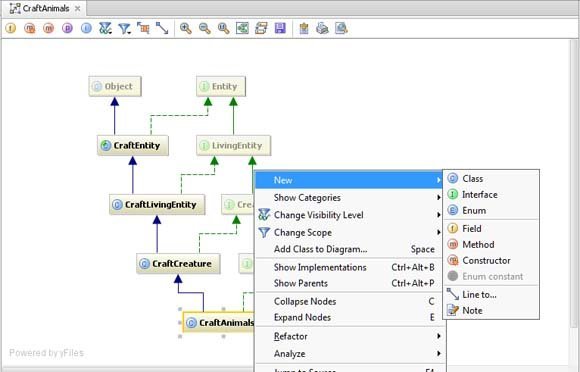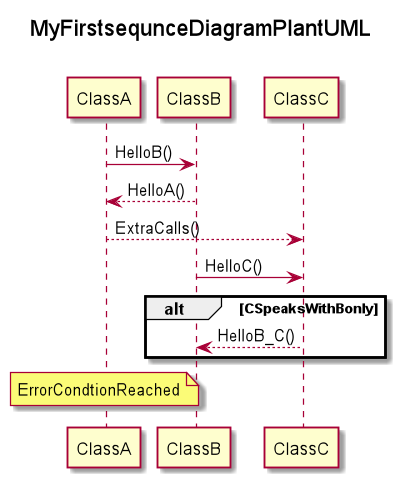

- #Sequence diagram generator intellij install#
- #Sequence diagram generator intellij archive#
- #Sequence diagram generator intellij windows#
If you want to view only direct dependencies between beans on the diagram, select Show Neighbours of Selected Nodes in the diagram toolbar. In the Select Diagram Type popup menu, click Spring Beans Dependencies. To open it in a popup window, select Diagrams | Show Diagram Popup Ctrl+Alt+U. This opens the diagram in a separate editor tab. You can also build a diagram for a class to see beans and their dependencies inside this class.įrom the context menu, select Diagrams | Show Diagram Ctrl+Alt+Shift+U. Right-click the bean for which you want to build a diagram. Use the Spring Beans Dependencies diagram to view and analyze dependencies between beans in your project. You can double-click a bean or a file on a diagram to open it in a dedicated tab in the editor.įor Spring Boot, you can also build the Runtime Beans diagram. Thank you for reading.Spring diagrams help you analyze dependencies in your application. That’s all folks! In this article, we’ve covered some important things for switching from Eclipse to IntelliJ IDEA. Just right click on a method for which you wanna generate sequence diagram and click on the Sequence Diagram context menu: References Once installed, you can generate Sequence Diagram with just few clicks and you can even export it as image
#Sequence diagram generator intellij archive#
Select the downloaded archive file and click ok
#Sequence diagram generator intellij install#
You can download the open source SequenceDiagram plugin from here and install it Got to Settings > Plugins and type lombok in the search box and install Enable Annotation Processing Generate Sequence Diagrams If you are using Lombok in your project, then you need to install the Lombok plugin Installation You can refer this article to learn more about Camel Case usages in IntelliJ. You can navigate to a file using Camel Case Instead, IntelliJ IDEA offers you to run the corresponding actions automatically on commit. the actions triggered automatically on save, such as reformatting code, organizing imports, adding missing annotations and the final modifier, etc. It is also worth noting that there is no save actions, i.e.

You can change this behavior via Settings/Preferences > Appearance & Behavior > System Settings: Physical saving to disk is triggered by certain events, including compilation, closing a file, switching focus out of the IDE, etc. So, you don’t need to keep on pressing the Ctrl + S like you do in eclipse whenever you do a change. You can also select the file using the select button in the Project View ‘Save’ button and Save Actions But IntelliJ has different shortcuts to perform the same

In Eclipse, you might have used shortcuts to select the opened file in Project Explorer. Locating Files on Project / System Explorer Now, you will be able to use most of the Eclipse keyboard shortcuts in Intellij. To use the Eclipse keymap, Go to File > Settings or Press Ctrl+Alt+S to open the Settings Window and Click on the Keymap tab on the left and select the Eclipse keymap from the dropdown as shown in the screenshot below For Eclipse users who prefer not to learn new shortcuts, IntelliJ IDEA provides the Eclipse keymap which closely mimics its shortcuts. IntelliJ IDEA shortcuts are completely different from those in Eclipse.
#Sequence diagram generator intellij windows#
Once the project is opened, click on the + icon in the “Maven” window on the right ( View > Tool Windows > maven) and then select the additional pom file you want to import: Shortcuts If you have multiple maven projects and you want those projects opened in one window, then you can open one project by selecting the pom.xml file. If you still want to have several unrelated projects opened in one window, as a workaround you can configure them all as modules in IntelliJ IDEA. If you have several unrelated projects, you can open them in separate windows. While in Eclipse you normally have a set of projects that may depend on each other, in IntelliJ IDEA you have a single project that consists of a set of modules. This means that you can work with only one project at a time. The first thing you’ll notice when launching IntelliJ IDEA is that it has no workspace concept. Locating Files on Project / System Explorer.


 0 kommentar(er)
0 kommentar(er)
